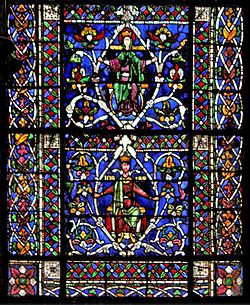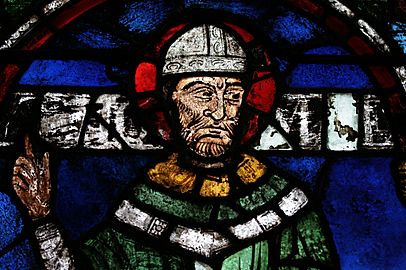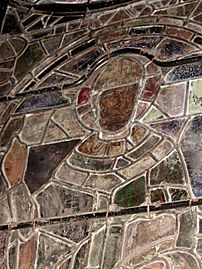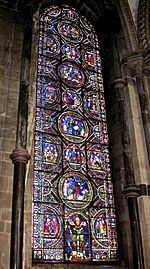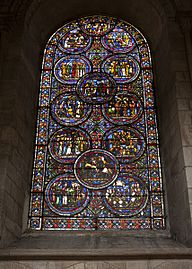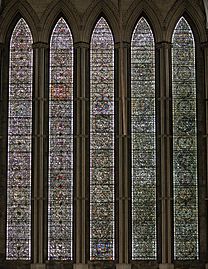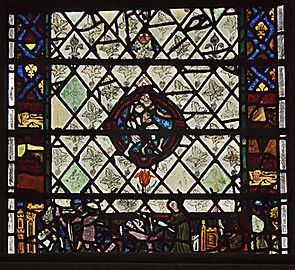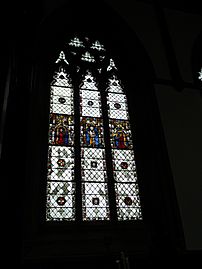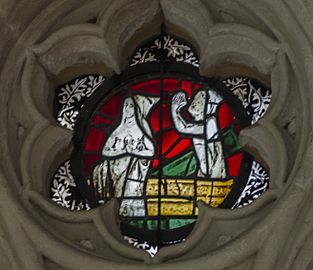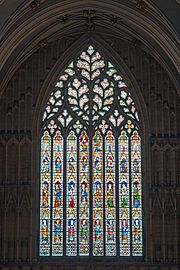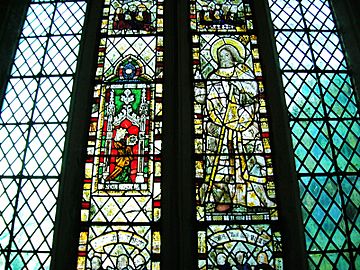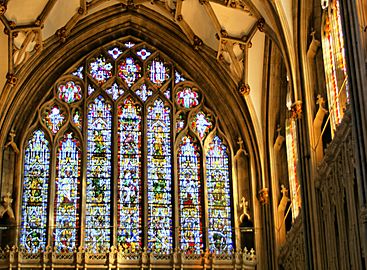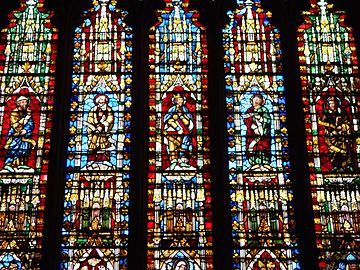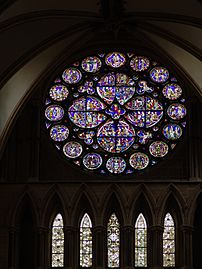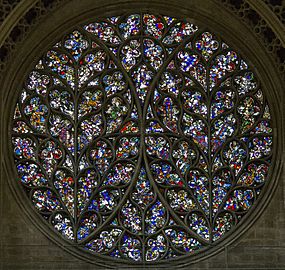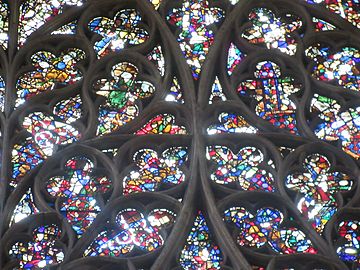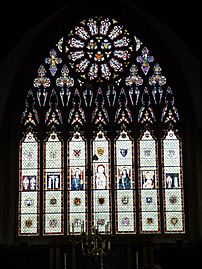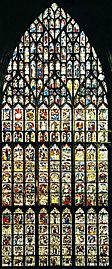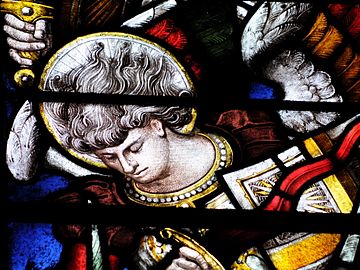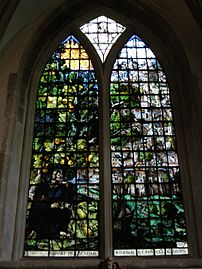English Gothic stained glass windows facts for kids
|
Detail of a Tree of Jesse Window from Canterbury Cathedral (late 12th–early 13th c.)
|
|
| Years active | 12th to 17th century |
|---|---|
| Country | England |
English Gothic stained glass windows are a super important part of English Gothic architecture. These amazing windows started appearing in the late 1100s and were popular until the late 1500s.
They changed a lot over time! At first, they were narrow windows filled with tiny, colorful glass pieces, like a mosaic. Later, they became huge, filling entire walls with a wide range of colors. The figures in them looked more real, too.
New techniques like using silver stain and special enamel paints made the windows even more detailed. Later windows also used lots of clear or white glass, called grisaille. This helped bring more light into the churches and cathedrals.
English Gothic windows followed the same style changes as English buildings. They came after the older Norman or Romanesque style windows. In the 1200s, the Decorated style appeared, which had two parts: one with straight lines and one with fancy curves. The last style was the Perpendicular Gothic, which lasted a long time, even into the 1500s.
Sadly, many original windows were destroyed during the English Reformation. But you can still see some amazing old glass in places like Canterbury Cathedral, Wells Cathedral, York Minster, and Westminster Abbey.
Contents
Early English Gothic: 12th to 13th Century
What They Looked Like
-
Face from the Thomas Becket window at Canterbury Cathedral (late 12th – early 13th c.)
-
Part of a Tree of Jesse window, York Minster (late 12th – early 13th c.)
Early English stained glass had very rich, deep colors. Think deep blues and ruby reds! The colors were often a bit streaky, which made them even more beautiful. These windows looked like mosaics, made from many small glass pieces.
The iron frames were also a big part of the design. In early windows, before stone patterns were common, leaded glass panels fit into iron frames. These frames became part of the picture. Sometimes, figures were so big they filled a whole window.
In lower windows, closer to people's eyes, each square in the iron frame held one picture. These were often framed by a circle and were called medallion windows.
Artists added details by painting with brown enamel, which was then baked onto the glass. They would scratch out lines for letters or patterns. There was no shading to make things look 3D yet.
Later in the 1200s, windows started to look more like paintings. They used the delicate stone patterns in the windows for decoration. They also added fancy pictures in the edges and often put main figures under beautiful arches.
Grisaille windows became popular in the 1200s. These windows used mostly clear or lightly colored glass. They let in much more light! They often had pretty flower designs, like cherry blossoms or ivy, around the edges. A famous example is at Merton College, Oxford.
How They Were Made and Their History
-
The Five Sisters window at York Minster (13th c.)
-
Detail of a pattern of grisaille at York Minster (13th c.)
-
Panel from York Minster showing the legend of Saint Nicholas rescuing three children (13th c.)
-
Grisaille window at Merton College, Oxford (13th c.)
The Gothic style for stained glass first appeared in France in 1142. The oldest windows in this style in England are probably at Canterbury Cathedral. The choir area of Canterbury was rebuilt by a French master builder, William of Sens. He brought the French Gothic style to England.
A very well-preserved window is the east window in "Becket's Crown" at Canterbury. Only a few parts of it are copies. The Thomas Becket window has a cool border with a repeating geometric pattern. This pattern became common in English windows. Another new thing in this window was a blue background painted on the glass, then scratched to make a pattern. This also became popular.
The Thomas Becket Window at Canterbury looks a lot like a window in Sens Cathedral in France. Thomas Becket stayed in Sens when he was exiled. It's likely the same artists made both windows.
During the English Civil War in the 1640s, some people damaged windows in cathedrals. They thought the images were wrong. But four windows in Trinity Chapel at Canterbury still have most of their original glass. Others were fixed later with copies.
Another important 13th-century window is the "Five Sisters" window at York Minster (around 1260). It's famous for its huge size and many pictures. You can also find early windows in the Jerusalem Chamber of Westminster Abbey.
Decorated Style: 14th Century
The 1300s brought big changes to English windows. This was partly because churches were built differently. Also, new ways of making glass appeared, like using silver stain to color it. This period matches the English building style called Decorated.
The Decorated style had two parts. The first, Geometric, used straight lines, squares, and circles in its stone patterns. The later part, Curvilinear, used graceful curving lines.
Later in the 1300s, after about 1360, the Perpendicular Gothic style arrived. This style used less and less colored glass. More and more windows were made with grisaille. Windows became taller and narrower, filling more of the wall space.
What They Looked Like
-
Resurrection scene from Wells Cathedral (early 14th c.)
-
West window of York Minster, in curvilinear Decorated style, with a heart-shaped top (14th c.)
-
The East window of Wells Cathedral (14th c.)
English cathedrals added more small chapels, and these needed more light. So, windows couldn't be just mosaics of small, dark, colorful pieces anymore. Each window section had tall, narrow lancet windows. These were usually topped with smaller round or clover-shaped windows.
Instead of many small figures, each tall window had one main figure, like a saint. These figures were colorful but surrounded by delicate patterns of white or lightly tinted glass. The edges often had designs of flowers, ivy, or geometric shapes. The tops and bottoms of windows were decorated with birds, angels, and funny creatures.
The glass at the top of the window often had painted details like arches and canopies. These matched the church's architecture. The people in the windows looked more natural, like drawings from medieval books.
Glass in the 1300s also got better. With better sand and heating methods, the glass was thinner and clearer. It didn't have the smoky look of earlier Gothic glass.
A big change was that windows used fewer pieces of glass. This was thanks to a new trick called silver stain. This involved baking a thin layer of glass mixed with silver onto the outside of the window. Depending on the mix, it could make bright yellow, orange, or green colors. This made windows much more colorful without needing many small pieces.
The Perpendicular style in glass had strong vertical lines. The blue and ruby backgrounds went up the whole height of every other section. The blue was lighter and grayer than before. White became very common, especially for figures, which only had touches of yellow stain.
History and Famous Examples
-
The Tree of Jesse or "Golden Window" on the west of Wells Cathedral (1340–45), using silver stain for its golden color
-
Detail of Lady Chapel windows, Wells Cathedral
The first use of silver stain in England was at York Minster around 1309. By the end of the century, it was used everywhere! It completely changed how English windows looked.
In English windows, the painted details were often subtle. The most detailed parts were in the stone patterns and iron bars that framed the window. For example, the west window of York Minster has glass in the Decorated curvilinear style. But its stone patterns, especially at the top, look like the French Flamboyant style. The curling shape at the top gave it the nickname "The Heart of Yorkshire."
Other important examples of the Decorated style include the Tree of Jesse Window, or "Golden Window," at Wells Cathedral (around 1345). This window uses silver stain for its golden color. You can also see beautiful windows in the choir of the Chapel of Merton College at Oxford.
Round Rose Windows
-
The Dean's Eye, Lincoln Cathedral (completed 1235)
-
The Bishops's Eye, Lincoln Cathedral, in Decorated curvilinear style (completed 1330)
Round "rose windows" were not very common in English Gothic cathedrals. But Lincoln Cathedral has two fantastic ones! They are called the Dean's Eye and the Bishop's Eye.
The Dean's Eye was started in 1192 and finished in 1235. The Bishop's Eye was finished much later, in 1330. It shows off the Decorated curvilinear style with its graceful curves.
Perpendicular and International Gothic: 15th to Early 16th Century
What They Looked Like
-
Great East Window, King's College Chapel, Cambridge
-
Window of Merton College, Oxford, showing how much white glass was used.
-
Perpendicular Great East window of York Minster
Thanks to better painting, silver stain, and flashed glass, figures in windows looked more real. They had shading and more details. The complex designs of Perpendicular architecture, with many thin columns and ribs, influenced the windows. This led to windows showing many angels in the upper parts.
Instead of pictures of the people who paid for the windows, you'd often see their family symbols (heraldry) or coats of arms. Pale backgrounds continued to be popular. These were often white panels decorated with flowers, animals, and coats of arms. They helped make the more colorful main figures stand out.
In the late 1400s, figures started to appear against different backgrounds, like landscapes, instead of just painted buildings.
Better painting techniques using enamel made the windows look even more like real paintings. The designs in English windows became more personal and told stories.
Sometimes, the challenge was how to add more color to the very pale white windows. Even the skin of the figures was usually white! In the 1400s, often less than a quarter of the window was colored glass. To add more color, sometimes light colors were put in the background. Colorful figures filled windows, surrounded by lightly colored glass panels instead of plain white. Gold touches (made with silver stain) were added to the painted architectural parts around the figures.
The Perpendicular style needed longer figures to fit the tall, narrow windows. In some windows, figures took up about half the window's height. The space above the figure was filled with painted architectural details. Faces in Late Gothic windows were drawn more finely, influenced by Flemish paintings.
History and Decline
-
Early Renaissance stained glass, from Christ Church Cathedral, Oxford (1516–1526)
-
Renaissance window at Christ Church Cathedral, Oxford by Abraham van Linge (17th century)
The International Gothic style appeared in the early 1400s. It was the last form of European Gothic art. It borrowed ideas from French, Dutch, and German artists. German engravings and Flemish paintings especially influenced stained glass across Europe, including England.
The English perpendicular style was another major influence. Even with wars like the War of the Roses, lots of new glass was made. English glass artists set up important workshops in York, Norwich, and Oxford. They made windows for cathedrals, nobles, and even rich merchants who wanted impressive windows for their new homes.
Glass artists became famous for their unique styles. Some known names were Thomas of Oxford and William of Coventry. Another famous artist was John Prudde, the King's glassmaker. He made glass for the Beauchamp Chapel in Warwick in 1447. Other great examples of this style are at Great Malvern Priory and All Souls' College at Oxford.
Flemish painting also had a big influence. England had strong trade and political ties with Flanders. Flemish glass artists started coming to England, sometimes causing arguments with local artists. Some important English windows, like those at Fairfield Church and King's College Chapel, Cambridge, were probably made by Flemish artists.
By the early 1600s, the art of English Gothic windows was fading. Some of the last windows, like those by Abraham Van Linge at Christ Church Cathedral, Oxford, looked more like large paintings with lead lines.
The change from Gothic stained glass to Renaissance glass is usually set around 1530. The first important group of Renaissance windows in England was made between 1516 and 1526. They were installed at King's College Chapel, Cambridge.
Images for kids
-
Detail of a Tree of Jesse Window from Canterbury Cathedral (late 12th–early 13th c.)
See also
- Stained glass
- Medieval stained glass
- French Gothic stained glass windows
- English Gothic architecture


